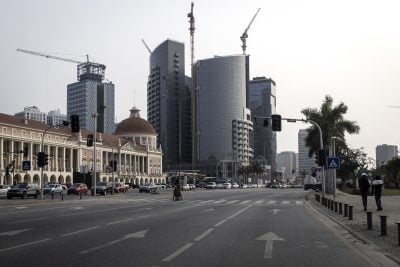Africa’s growth has been second only to that of Asia since 2000, but a recent report argues that new policies are needed to deliver sustainable growth and eradicate inequalities. Review by Stephen Williams
Despite strong growth between 2000 and 2016, quality jobs are scarce and inequalities remain high across Africa. If the aims of the African Union’s Agenda 2063 strategy – the creation of a united, integrated, peaceful and prosperous continent – are to be met, new development strategies will have to be adopted, say the authors of Africa’s Development Dynamics: Growth, Jobs and Inequalities.
The report, produced by the African Union Commission (AUC) with the OECD Development Centre, aims to be more than just another document to be filed away, unread, in a dusty cabinet. The first edition of what will be an annual economic report by the AUC, it is intended to further the aims of Agenda 2063 by fuelling debate and bringing an African contribution to fair and sustainable models of development.
In a presentation given in late October at the OECD’s Paris HQ, Mario Pezzini, the director of the OECD Development Centre and special advisor to the OECD secretary general on development, commented that he saw the publication not simply as a report, but as a platform to address Africa’s policy choices.
The report is arranged over eight chapters, with chapters 1-7 examining the current challenges at continental and regional levels, and the eighth charting a way forward in the form of proposed policy actions.
Current strategies will not deliver
The first two chapters focus on Africa’s integration within the global economy and why new development strategies are needed.
Although Africa experienced strong economic growth rates between 2000 and 2016, averaging 4.6% annually, the authors underline five reasons why current strategies will not deliver the aims of Agenda 2063. Growth remains volatile, and has not improved wellbeing as much as it has in the rest of the world. Nor has it produced enough quality jobs for the growing labour force. Furthermore, reducing inequality is essential to make growth “more inclusive and resilient”, and structural reform will be hard to sustain if firms do not increase their productivity.
The authors also argue that development policies must take account of the “five megatrends” affecting Africa’s integration into the global economy, assessing the risks, opportunities and policy implications of each for African countries.
The narrative is well known. The report says that global wealth is shifting, with emerging countries today producing more than half of global output. As a result, Africa’s linkages and partnerships with the rest of the world are increasing – an emerging reality that offers Africa new markets and the chance to learn from new manufacturing methods, but also creates new sources of competition for African producers. Nevertheless, the authors argue that the expansion of domestic industry can be sustained by the continent’s population boom, which ought to result in a “demographic dividend” if local economies can supply enough jobs and basic services to meet the growing demand. Yet rapid urbanisation, development’s by-product, is changing economic structures and posing new challenges. Furthermore, “green growth” strategies are needed to adapt to climate change.
Ten key actions
Chapters 3-7 of the report look in detail at the dynamics of growth, jobs and inequalities in Southern, Central, East, North and West Africa respectively.
It is in the eighth and final chapter that the report offers an overall response to Africa’s challenges and opportunities, with a list of 10 key policy actions to address the megatrends and meet the targets of Agenda 2063, as well as related UN Sustainable Development Goals:
- Encourage investment for domestic private sector development.
- Help the private sector to diversify production and exports.
- Strengthen linkages between rural and urban economies.
- Foster green growth.
- Expand education while improving the quality of education and skills.
- Increase the coverage of social production systems, including labour and health.
- Boost Africa’s engagement with its global partners.
- Deepen regional integration.
- Mobilise domestic resources.
- Enhance economic and political governance.
Each of these main actions is broken down into a number of proposals that are explained in detail. Sets of policy actions tailored specifically for each of the five regions are also included.
Progress is needed
If Africa wants to take full opportunity and capitalise on the megatrends that the report says will shape its future, policymakers will have to start making real progress on the 10 actions laid out in the report.
The African Continental Free Trade Agreement (AfCFTA) offers a path to progress on several of these indicators. If fully ratified it would make Africa the world’s largest free trade area, and, as the report claims, “fully liberalising trade in goods could boost Africa’s GDP by 1% and total employment by 1.2%. Intra-African trade could grow by 33% and Africa’s total trade deficit could be halved.”
The AfCFTA has been signed to date by 49 African countries, but the continent’s largest economy, Nigeria, remain a holdout. As a result there are significant doubts over whether it will ever meet its full potential. If the report has the effect of concentrating policymakers’ minds on the importance of signing the deal, it may yet reach its authors’ lofty ambitions.

Free – African Union/Organisation for Economic Cooperation & DevelopmentISBN: 978-92-64-30249-5
Want to continue reading? Subscribe today.
You've read all your free articles for this month! Subscribe now to enjoy full access to our content.
Digital Monthly
£8.00 / month
Receive full unlimited access to our articles, opinions, podcasts and more.
Digital Yearly
£70.00 / year
Our best value offer - save £26 and gain access to all of our digital content for an entire year!

 Sign in with Google
Sign in with Google 




